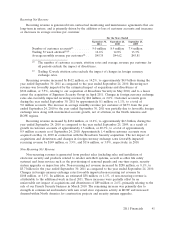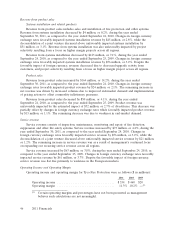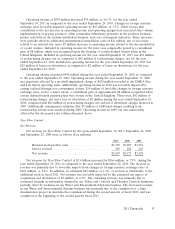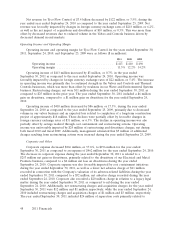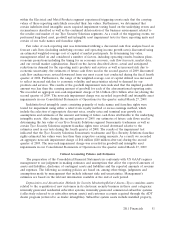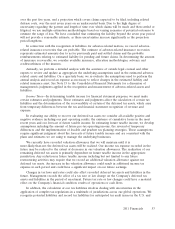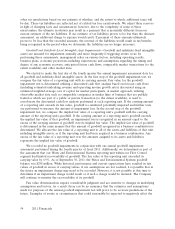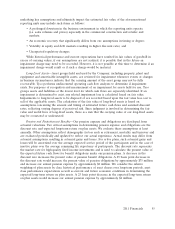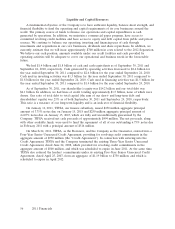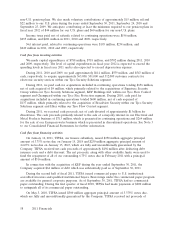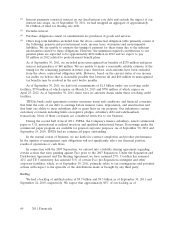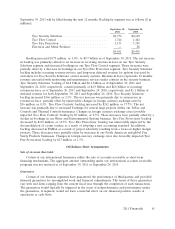ADT 2011 Annual Report Download - page 154
Download and view the complete annual report
Please find page 154 of the 2011 ADT annual report below. You can navigate through the pages in the report by either clicking on the pages listed below, or by using the keyword search tool below to find specific information within the annual report.within the Electrical and Metal Products segment experienced triggering events such that the carrying
values of these reporting units likely exceeded their fair values. Furthermore, we determined that
certain indefinite-lived intangible assets required impairment testing based on the underlying events and
circumstances described as well as the continued deterioration of the business environment related to
the retailer end market of our Tyco Security Solutions segments. As a result of the triggering events, we
performed long-lived asset, goodwill and intangible asset impairment tests for these reporting units and
certain of our trade names and franchise rights.
Fair value of each reporting unit was determined utilizing a discounted cash flow analysis based on
forecast cash flows (including underlying revenue and operating income growth rates) discounted using
an estimated weighted-average cost of capital of market participants. In determining fair value,
management relied on and considered a number of factors, including operating results, business plans,
economic projections including the timing for an economic recovery, cash flow forecasts, market data,
and our overall market capitalization. Based on the factors described above, actual and anticipated
reductions in demand for the reporting unit’s products and services as well as increased risk due to
economic uncertainty, the estimates of future cash flows used in the second quarter of 2009 discounted
cash flow analyses were revised downward from our most recent test conducted during the fiscal fourth
quarter of 2008. Furthermore, the range of the weighted-average cost of capital utilized was increased
to reflect increased risk due to economic volatility and uncertainties related to demand for our
products and services. The results of the goodwill impairment tests indicated that the implied goodwill
amount was less than the carrying amount of goodwill for each of the aforementioned reporting units.
We recorded an aggregate non-cash impairment charge of $2.6 billion ($2.6 billion after-tax) during the
second quarter of 2009. The non-cash impairment charge was recorded in goodwill and intangible asset
impairments in our Consolidated Statements of Operations for the quarter ended March 27, 2009.
Indefinite-lived intangible assets consisting primarily of trade names and franchise rights were
tested for impairment using either a relief from royalty method or excess earnings method, which
include the selection of appropriate discount rates, royalty rates and terminal year growth rate
assumptions and estimates of the amount and timing of future cash flows attributable to the underlying
intangible assets. Also, during the second quarter of 2009, our estimates of future cash flows used in
determining the fair value of our Tyco Security Solutions segment Sensormatic tradename as well as
certain Tyco Security Solutions segment franchise rights were revised downward relative to the
estimates used in our tests during the fourth quarter of 2008. The results of the impairment test
indicated that the Tyco Security Solutions Sensormatic tradename and Tyco Security Solutions franchise
rights estimated fair values were less than their respective carrying amounts. As a result, we recorded
an aggregate non-cash impairment charge of $64 million ($40 million after-tax) during the second
quarter of 2009. The non-cash impairment charge was recorded in goodwill and intangible asset
impairments in our Consolidated Statements of Operations for the quarter ended March 27, 2009.
Critical Accounting Policies and Estimates
The preparation of the Consolidated Financial Statements in conformity with US GAAP requires
management to use judgment in making estimates and assumptions that affect the reported amounts of
assets and liabilities, disclosure of contingent assets and liabilities and the reported amounts of revenue
and expenses. The following accounting policies are based on, among other things, judgments and
assumptions made by management that include inherent risks and uncertainties. Management’s
estimates are based on the relevant information available at the end of each period.
Depreciation and Amortization Methods for Security Monitoring-Related Assets—Tyco considers assets
related to the acquisition of new customers in its electronic security business in three asset categories:
internally generated residential subscriber systems, internally generated commercial subscriber systems
(collectively referred to as subscriber system assets) and customer accounts acquired through the ADT
dealer program (referred to as dealer intangibles). Subscriber system assets include installed property,
2011 Financials 51


